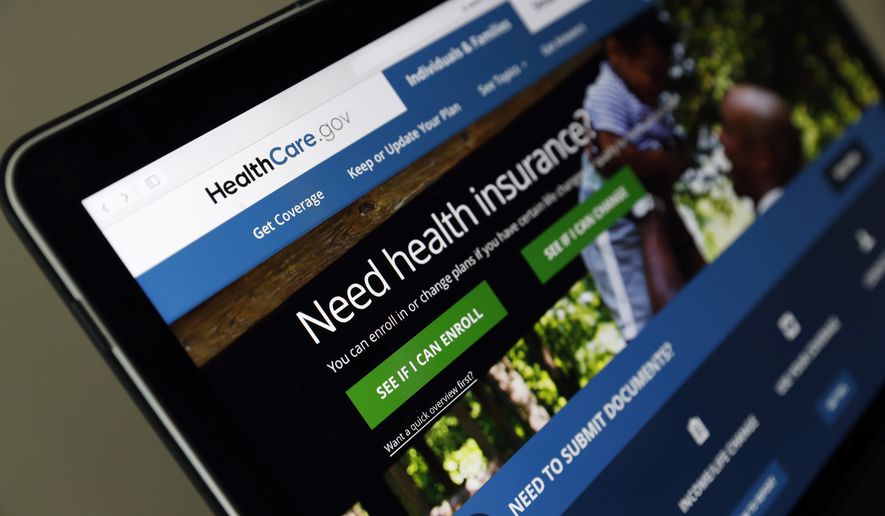Obamacare customers will see higher premiums and fewer choices when they begin enrolling Wednesday for coverage next year, according to a series of studies that found the health care law’s struggles are growing.
Premiums for benchmark silver-level plans on the federal HealthCare.gov portal will rise 37 percent, and eight states will have only one insurer offering plans, the Health and Human Services Department reported Monday, as customers shun Obamacare and insurers jack up rates to make up for President Trump’s decision to halt “cost-sharing reduction” payments to the insurance companies.
But there are bargains to be had, the government said. In a quirk of pricing and government controls, top-level gold plans may be cheaper than silver plans in some states, the HHS report said.
State officials said it’s a bright spot in an otherwise challenging climate for the law after Mr. Trump slashed the enrollment period in half and cut outreach funds.
Howard Haft, interim executive director of the Maryland Health Benefit Exchange, urged uninsured residents to check out their options this year, “even if they’ve looked before and chose not to enroll.”
“From what they’ve heard and read, many may be surprised to find plans comparable to or even cheaper than a year ago, if they qualify for financial help,” he said.
Indeed, the average tax credit subsidy the federal government will pay to help consumers afford coverage on the exchanges will rise by 45 percent compared with last year, meaning taxpayers will pay an ever-higher tab to keep people on their coverage.
Those who don’t qualify for government subsidies, meanwhile, will feel the brunt of rising premiums, likely chasing some out of the market entirely.
Mr. Trump’s HHS does not plan to estimate an enrollment target, breaking with the practice under President Obama, when the department regularly guessed each year at how many people would use the exchanges.
Several outside groups stepped into the gap to produce their own estimates.
The liberal Center for American Progress, citing multiple studies, predicted Monday that the exchanges will drop by up to 2 million customers next year. The center said enrollment of 12.2 million would have been stable if Mr. Trump attempted “good faith” efforts to maintain the marketplaces.
S&P Global, a credit ratings agency, said it expects enrollment to fall by up to 13 percent, leaving 10.6 million to 11.4 million signups.
It cited reduced outreach, an enrollment period that will last 45 days — down from 90 — and higher costs for unsubsidized consumers.
Many customers use HealthCare.gov as a starting point before they are directed to state-run portals, so those marketplaces are worried about a downstream impact on their own enrollment.
“I doubt it’s going to grow. I hope it doesn’t shrink,” said Mila Kofman, executive director of the city-run exchange in the District of Columbia.
“I’m very worried about new customers,” she said. “And there’s just been so much confusion created by everything the federal government has done, so I’m worried about retention.”
Mr. Trump’s HHS says the law is to blame for stumbles heading into next year because lackluster enrollment in the early rounds created a sick and costly risk pool that boosted rates and scared off insurers.
The total number of issuers offering plans is down to 132 from 237 last year — a 44 percent decrease.
Eight states will have only one insurer operating on their exchanges, and 29 percent of enrollees will be able to choose from only one insurer, up from 20 percent last year and 2 percent in 2016.
“This data demonstrates just how rapidly Obamacare’s exchanges are deteriorating with skyrocketing premiums year after year, more than half of Americans with no more than two insurers to choose from, and the taxpayer burden exploding. There is an urgent and serious need to repeal this failed law and replace it with patient-centered solutions,” HHS spokeswoman Caitlin Oakley said.
Mr. Trump frequently says the 2010 health care law is “dead” and he will resume repeal-and-replace efforts with congressional Republicans in the spring, though his administration must oversee a round of 2018 signups that lasts until Dec. 15.
A bipartisan bill in the Senate would restore the cost-sharing payments for two years and offer rebates to consumers and taxpayers, so insurers don’t also benefit from the higher rates they set. The bill would save taxpayers nearly $4 billion through 2027, the Congressional Budget Office says.
Mr. Trump hasn’t endorsed the deal, saying it’s not tough enough as he sets the table for another repeal effort next year.
• Tom Howell Jr. can be reached at thowell@washingtontimes.com.




Please read our comment policy before commenting.